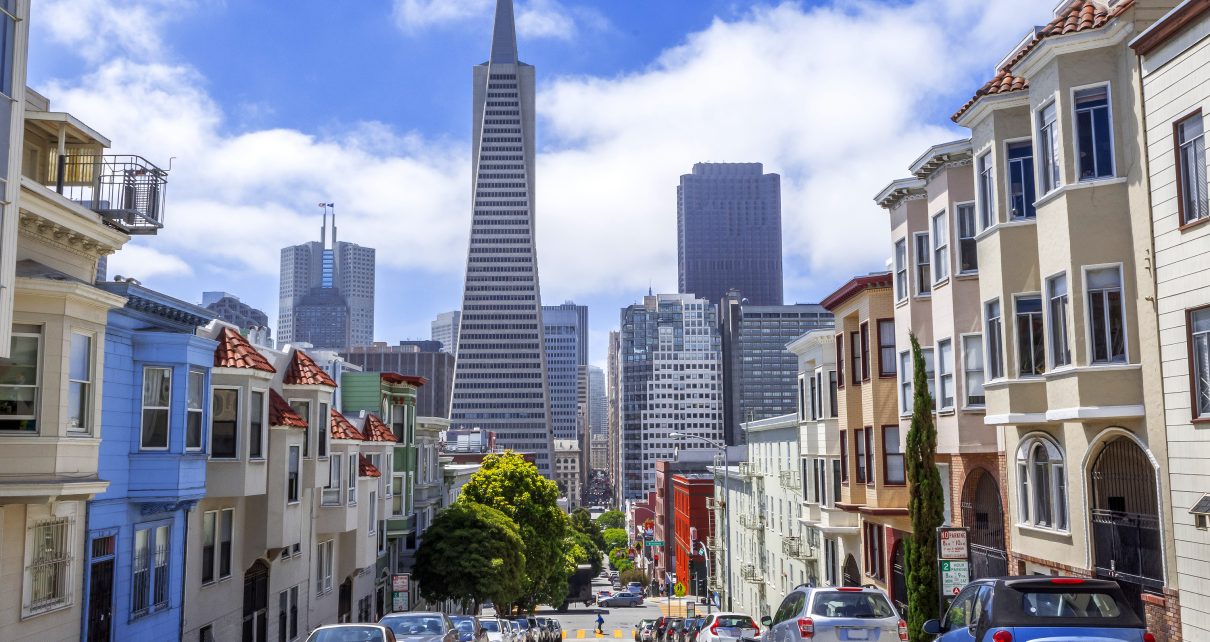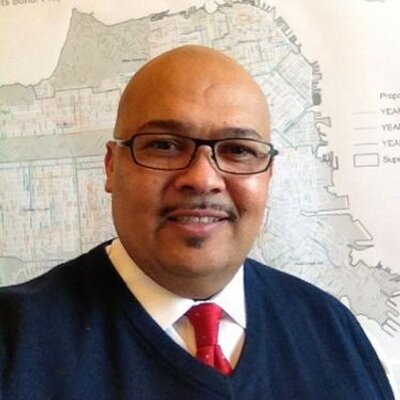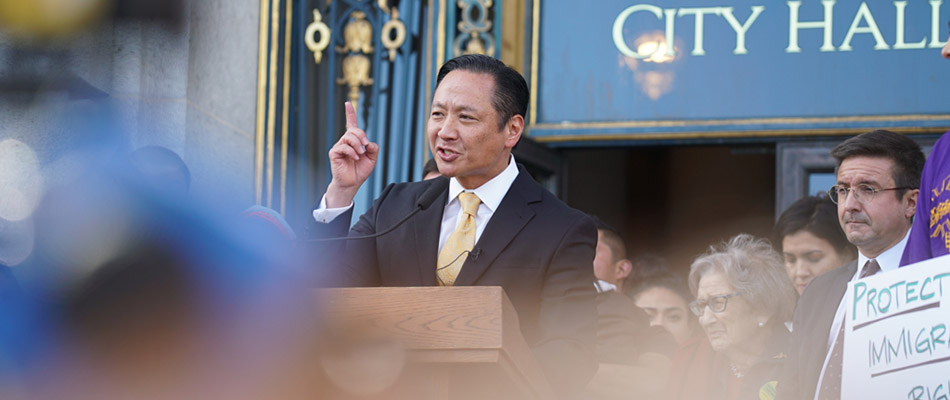
Montgomery St. and Skyline of Downtown areas of San Francisco, CA. (Photo: Randy Andy/ Shutterstock)
CA Public Utilities Commission Votes 3-1 To Expand Robotaxi Services In San Francisco
‘Public safety decisions should not be made by regulatory bodies that are in the pocket of Big Tech’
By Evan Symon, August 11, 2023 11:53 am
The California Public Utilities Commission (CPUC) voted 3-1 on Thursday to expand driverless taxi services in San Francisco despite heavy opposition from both residents, unions, and some lawmakers.
Since June 2021, driverless taxis have been a fixture in the city, with San Francisco serving as sort of a testing ground for several companies. Cruise, a subsidiary of General Motors, was the first driverless taxi company to get permission, although soon thereafter were followed by several other companies, including Alphabet’s Waymo service. However, the race for the services to expand soon hit several snags, which included the San Francisco Municipal Transportation Agency (SFMTA) raising several safety concerns and challenges.
Despite the safety issues, which included dropping people off in busy intersections and not always going to curbs for the pickup and drop off of passengers, Cruise and Waymo continued to expand. In 2022, CPUC issued Drivered Deployment permits to both companies in the city. Under the new permits, while the companies were still limited to where passengers could go, companies could now charge people fares rather than operate under the free fare system. Since March of 2022, both companies have been allowed to operate during certain hours of the day, with Cruise offered paid rides in about 1/3rd of the city and Waymo still offering free trips as the technology improves under the constant usage. As of August 2023, Cruise has 300 vehicles driving around San Francisco at night and 100 during daytime hours, with Waymo only operating 250 vehicles during the day.
While both companies applied for more expansions from CPUC, the number of complaints against robotaxis grew in San Francisco. Many taxi and rideshare drivers opposed the robotaxis for threatening their livelihoods, and safety concerns grew even more. Reports of blocked traffic, blocking emergency workers, blocking mass transit, and other worrying behavior quickly became commonplace in the city. Both the companies and residents opposed to the robotaxis clashed for months, leading up to the Thursday CPUC meeting over the proposed expansion.
During the seven-hour meeting, Cruise and Waymo petitioned for permission to offer paid rides at any time during the day throughout the city, and not be constrained by prior geographic limits, designated operating hours, and paid ride limits. Both companies stressed that the expansion in San Francisco, as well as to other cities like Santa Monica and Los Angeles, would be vital for not only the companies, but for autonomous driving technology as well.
CPUC votes 3-1 to expand robotaxis in SF despite public opposition
However, the bulk of the meeting was filled with local residents, city workers, and city officials voicing opposition against the plan. Some within the SFPD and SFFD pointed to dozens of incidents in the last six months where rescue operations had been impeded by self-driving cars. Officials stressed that the incidents, which included driverless cars not moving when being told to by first responders on scene, needed to be solved first before more expansion is given.
“Our folks cannot be paying attention to an autonomous vehicle when we’ve got ladders to throw,” said San Francisco Fire Chief Jeanine Nicholson. “I am not anti-technology, I am pro-safety.”
Others during the meeting went after the fact that big tech was behind the driverless cars, and that they were treating San Francisco as a testing area rather than respecting the city. Disabled riders also expressed concerns over pedestrian safety, while unions and taxi/rideshare drivers pointed to the massive job loss that would occur if more driverless cars went on the roads. For the latter group, they specifically stressed the need for drivers to be in the vehicles as a safety precaution and that state action, like AB 316, which would require drivers to be in driverless trucks if passed, could force Waymo and Cruise to have drivers in the cars.
Also called out by many during the meeting was the status of CPUC Commissioner John Reynolds. Opponents voiced several times that they felt that Reynolds should not be able to vote, as he had been a general counsel for Cruise in the past.
Despite the concerns, CPUC voted 3-1 to allow the expansion. The approval did however note that the number of driverless vehicles on the road could be limited in the future if there are more reports of safety incidents occurring.
“Today is the first of many steps in bringing AV transportation services to Californians,” said CPUC Commissioner Reynolds on Thursday at the end of the hearing. “While we don’t yet have the data to judge AVs against the standard that humans are setting, I do believe in the potential of this technology to increase safety on the roadway.”
Commissioner Darcie Houck added, “If there are further reports of incidents, the CPUC could vote to limit the number of vehicles allowed on the road or revoke the companies’ permits altogether. A broad range of opinions have been presented to us by the public regarding the resolutions before us today. I do not take this decision lightly.”
Both Cruise and Waymo applauded the vote on Thursday, with the companies saying that the day marked the true beginning of commercial operations in the city.
“The decision is a major moment in the history of autonomous vehicles,” Waymo co-CEO Tekedra Mawakana said. “Today’s permit marks the true beginning of our commercial operations in San Francisco.”
Cruise CEO Kyle Vogt also tweeted out “Thrilled to announce that the California Public Utilities Commission just approved Cruise for fared operation 24/7 across all of San Francisco! It’s a huge milestone for the AV industry, but even more importantly a signal to the country that CA prioritizes progress over our tragic status quo. We share the CPUC’s commitment to delivering safer, cleaner and more accessible transportation options, and remain committed to collaborating closely with regulators to push toward this critical goal.”
Thrilled to announce that the California Public Utilities Commission just approved @Cruise for fared operation 24/7 across all of San Francisco!
It’s a huge milestone for the AV industry, but even more importantly a signal to the country that CA prioritizes progress over our…
— Kyle Vogt (@kvogt) August 11, 2023
Opponents responded, both decrying the CPUC decision and vowing for state legislation to limit driverless vehicles in the near future.
“The CPUC ruling is irresponsible and shows a complete disregard for public safety. In addition to ignoring the city’s nearly 70 reported safety incidents involving robotaxis this past year, it has completely bypassed the recommendations of public safety officials, including the San Francisco Fire Chief and Police Officers Association. This undemocratic process caters to executives at Waymo and Cruise – not San Francisco residents,” said Teamsters Western Region International Vice President Peter Finn in a statement.
“Public safety decisions should not be made by regulatory bodies that are in the pocket of Big Tech. This is blatantly obvious given that Commissioner John Reynolds, who was the lead attorney for Cruise right before his appointment, did not recuse himself from today’s ruling. It’s critical that decisions affecting the safety of California drivers and pedestrians are made by our elected officials.”
“That’s why the Teamsters support Assembly Bill 316, bipartisan legislation that would require a trained human operator behind the wheel of AVs weighing over 10,000 pounds. As state regulators carelessly approve the expansion of AVs in California, it is critically important that AB 316 becomes law.”
- Former Assembly Speaker Anthony Rendon Launches Run For State Superintendent - July 28, 2025
- New Report Finds 19% Of All Homes in California are Investor Owned - July 28, 2025
- Kamala Harris And the Young Voter Problem - July 26, 2025








that the cpuc holds sway in any way over taxis says everything that is wrong with california’s extreme you-don’t-own-your-ideas-we-do philosophy of governance
Why do millions of Californians allow five unelected Democrat bureaucrats to issue dictates like this? It’s past time that these unelected bureaucrats were sent packing: Alice Busching Reynolds, President; Genevieve Shiroma, Commissioner; Darcie L. Houck, Commissioner; John Reynolds, Commissioner; and Karen Douglas, Commissioner.
I agree , TJ !
I believe that the CPUC is Newsom’s appointees.
Are we , the public, allowed to see how much money they receive , because every meeting
seems to result in a blatant vote against the public and for big corporations.
I find it ironic that San Francisco will do everything in their power to eliminate car ownership by its residents YET they want MORE driverless cars and all the problems that they bring. The driverless car companies must have really good lobbyists.
One day after three unelected bureaucrats on the CPUC implemented a massive expansion of the robotaxis, there was a 10-car driverless traffic jam in San Francisco that blocked two narrow streets in the center of the city’s lively North Beach bar and restaurant district. The jam clogged up Vallejo Street and two corners on Grant, as human drivers were unable to maneuver around the automated vehicles. The robotaxis sat with their parking lights flashing for 15 minutes before “waking up” and eventually moving on.
It was blamed on a huge demand for services when the Outside Lands concert in Golden Gate Park (6 miles away) ended and band width got jammed. Cruise, who oversees the project, blamed cellphone carriers for the problem claiming that Outside Lands impacted LTE cell connectivity and ability for RA advisors to route cars.
One of the three votes in favor was a Commissioner who jumped from the CPUC to a paying job for Cruise, and then jumped back to the CPUC. He didn’t recuse himself for the vote despite a glaring conflict of interest. California is a mega corrupt state? (https://www.zerohedge.com/markets/ten-cruise-robotaxis-brick-san-fran-streets-causing-massive-traffic-jam)